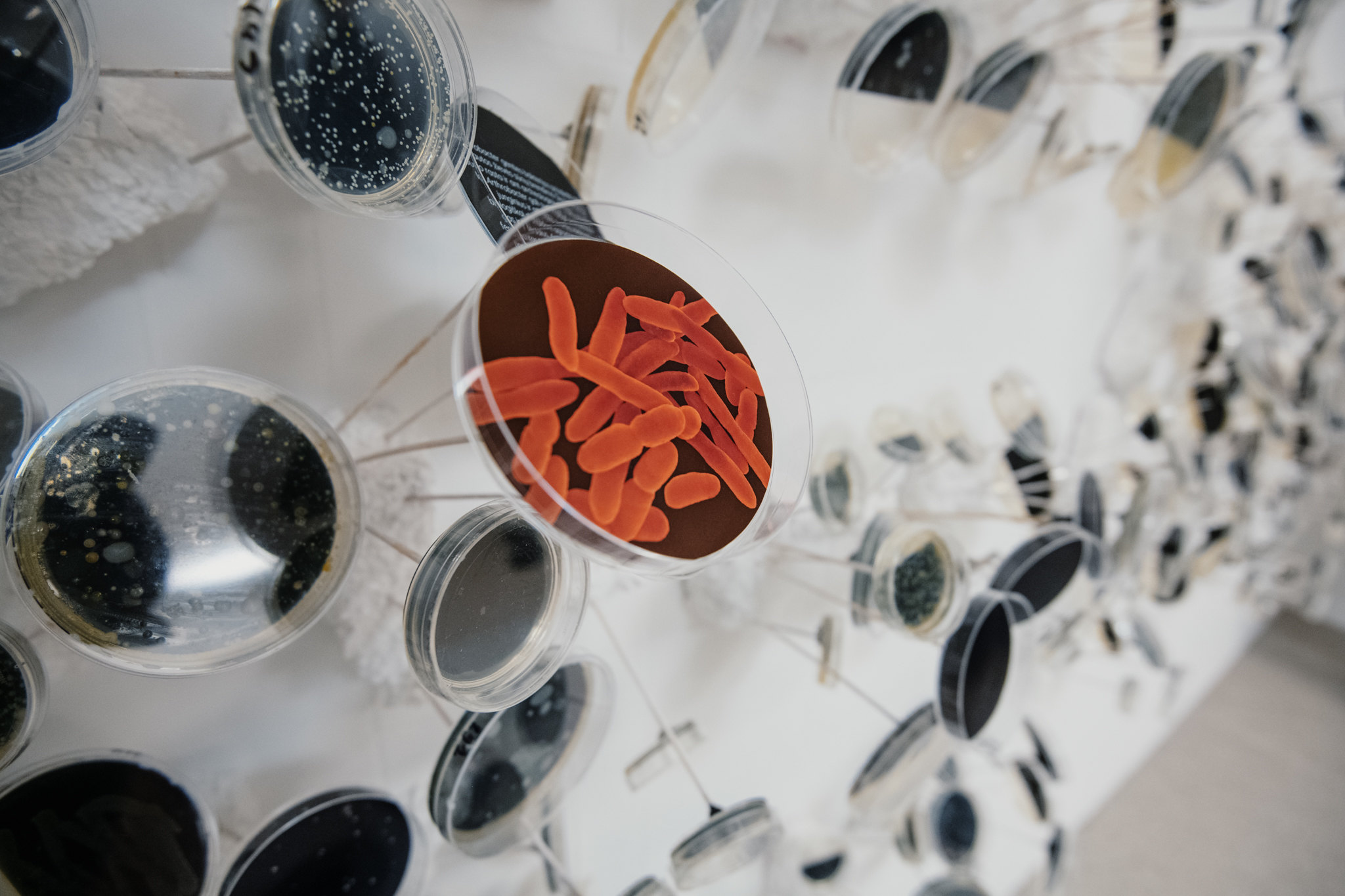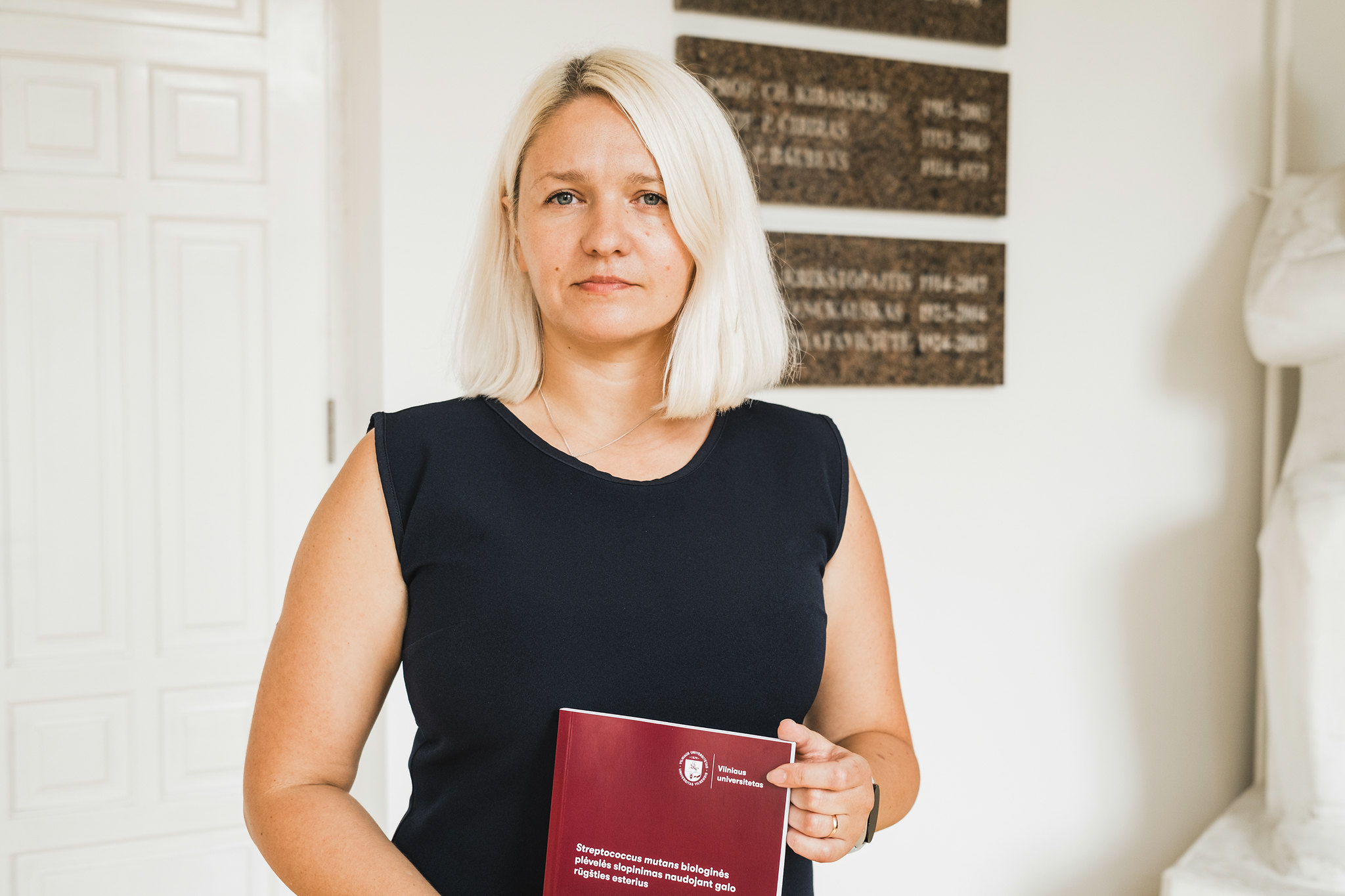Dr. Vika Gabė: A Scientist Does Not Seek Quick Results

“Scientific research requires passion, doing things not out of calculation, but out of vocation. Sometimes you have to ignore logic and listen to your inner voice, your intuition, trust yourself if you have some ideas and dare to follow them,” said Dr. Vika Gabė, who has defended her PhD thesis at the Medical Faculty this year on “The Inhibition of the Biofilm of Streptococcus Mutans Using Gallic Acid Esters”. We talked to Dr. V. Gabė about her thesis research, her love for science, the challenges she has faced and her future career plans.
What was your dissertation research about? What was your aim?
Streptococcus mutans is the main bacterial species involved in causing dental caries. This bacterial species is highly adapted to survive in the human mouth. The ability of S. mutans to form a biofilm determines their mutant adaptation and the resulting colonisation of oral surfaces. The most commonly colonised surface is the tooth. The bacteria produces an adhesive film (sticky polymers) from the sugars and other carbohydrates in the mouth, which then adheres to the surface of the tooth, allowing the bacteria to settle and multiply.
Such a film is difficult to remove from the tooth surface. The bacteria itself does not cause much damage, but the metabolites (acids) released during the process, erode tooth enamel. This leads to cavities in the tooth that, if left untreated, lead to an infectious process and tooth decay. Serious infection can lead to tooth loss. There is a lot of talk about tooth decay, its prevention and professional dental hygiene. Nevertheless, tooth decay remains one of the most common dental conditions in the world.
Because the problem persists, scientists continue to look for ways to prevent tooth decay from developing. The main aim of my thesis research was to test certain substances, gallic acid esters, which might affect the ability of S. mutans to form an adhesive polymer film, that allows the bacteria to attach themselves to the surface of the tooth, provoking the production of acids, leading to the process of demineralisation of the tooth.
Four substances were tested: methyl gallate, ethyl gallate, octyl gallate and lauryl gallate. We found that these substances do inhibit the formation of the biofilm. It is important to note that they do not kill the bacteria in the human mouth, but inhibit the mechanism of biofilm formation. We have also investigated this at the gene level: we wanted to find out what the gene expression is, and perhaps what genes these substances inhibit. We found that the effect is more pronounced depending on the length of the terminal acid ester chain: the longer the chain, such as octyl or lauryl gallate, the stronger the inhibition of biofilm formation.
Why did you choose this topic for your thesis?
We were involved in a joint project with partners from Israel. We were asked to test extracts from fruits that grow in Israel, such as Rhus coriaria (Sicilian sumac), Terminalia bellirica (the Bedda nut tree) and so on, to see if they inhibited the biofilm-forming capacity of S. mutans. This is where the “journey” of the study began: we found that the extracts were quite effective in inhibiting biofilm formation. We investigated which parts of the extracts were the most effective, and we found that methyl gallate was the most effective fraction or group of chemicals. Methyl gallate is the gallic acid ester with the shortest chemical chain. After analysing and testing the literature, it became clear that there was still not enough data available – only a few research groups have previously done something similar in this area. So we decided to continue testing gallates. The results showed that the inhibition of biofilm formation becomes more effective as the length of the chemical chain increases. I was actively involved in this research myself, carrying out biofilm cultivation work, measurements, and, in parallel, publishing five scientific papers on the subject. The results provided excellent material for a more serious scientific paper, which is how I came to be offered the opportunity to write my dissertation on it.
What are the societal benefits of your thesis research?
It is too early to talk about direct benefits; we just have some knowledge about what substances inhibit biofilm formation. The great thing is that these substances are found naturally in nature, in plants. Registered in the European Union as safe for use and non-toxic, they have been used in the food and cosmetic industries for almost half a century. Their neuroprotective, anti-inflammatory and anti-cancer properties are currently being researched. It is very good news that these substances, which are not synthetic but occur naturally in nature, have great potential. The aim of further research therefore, is to put this knowledge into practice: the prevention of tooth decay, oral care products such as toothpaste, oral rinses and so on. We have partners with whom we have already discussed this and we will continue our research in due course.

What were some of the difficulties you faced in preparing your thesis?
In terms of the research itself, there were certainly some challenges. Sometimes it just was not possible to achieve the desired result. Also, the fact that when an experiment underway (there were 41 experiments over the whole period), each one took about a week. This means that you have to take the time to prepare to grow the bacteria. You have to come in the next day exactly 18 hours later, prepare a special plate, extract the concentrations, place the bacteria on the plate, and incubate them again. Then, come in a day later – exactly 24 hours later – to fix the film, measure the pH of the film, and before you can do that, you have to prepare the biofilm itself, to extract it, by first removing it, from the bottom of the “small wells” where it had formed. This was about a week’s work. There were days when I failed, when I encountered some obstacles, and that could be very frustrating. However, I am the type of person who would start the next day with renewed energy. I would reflect on what went wrong, what I had not taken into account, what conditions might need to be changed, and I would start again the next day (or the next week). As a result, I had to plan everything in a periods lasting one week. Of course, if I had other things to do, it was not always easy to combine everything. Then the experiment would have to move to the next week. There were certainly situations where things did not go the way I had wanted or expected them to. My supervisor and I would always discuss the results of the research, for example, what concentrations would be the best choice. These were the main challenges. But every challenge is just a “driving factor” to keep moving forward.
Can you tell us about your path towards your dissertation as a researcher?
I completed my bachelor’s and master’s degree in biology at Vilnius University, under the then, Faculty of Natural Sciences, and only later was I at the Faculty of Medicine. I was asked if I would like to work with students – the faculty had noticed that I was doing well, and I agreed. It was a challenge for me. Of course, when I was studying biology, I had to take courses in human anatomy, histology, etc. (I attended lectures at the Faculty of Medicine), but I am a biologist by training, not a doctor. Today, I am still learning, extending my knowledge, and I remain very interested. It is true that when I was studying natural sciences, I was always thinking about my dissertation... I loved science, research, experiments, and the whole micro-world. However, it was the joint project with my Israeli partners that made me take my dissertation seriously. I am very happy about that. I guess I can’t live without science, research, and working with students (smiling). In science, you do things and you don’t always know if the result will be what you expect. Nevertheless, I am convinced that a research scientist does not look for a quick result, and does not expect innovative ideas to be implemented quickly and easily. A scientist’s job is like a gardener’s: you feel a constant obligation to lay the foundations for the future, to show the way for those who are yet to come. The most important thing is not to dwell on failures, to take them as experiences and move on.
If it were possible to “rewind” time, are there any things you would do differently in your thesis research?
Of course! I would like to add to the research I have done, to test a few more materials. I received particularly useful comments while defending my dissertation. For example, in the study we used water as a solvent for two substances and dimethyl sulfoxide for the other two. The comment I received was that the substances that were perfectly soluble in water, also needed to be tested with another solvent. So we would like to repeat this part of the test to see what effect a different solvent might have on the results. In the future, I am keen to work on mixed biofilms, i.e. when other bacteria, such as fungi (Candida fungi or others), are involved in the biofilm formation initiated by S. mutans. They are also involved in this process, binding together, producing acids, and again, the “result” is tooth decay. My future wish would be to do research into polymicrobial biofilms: perhaps even testing them with the same materials used in my original research. So you can see, I definitely have ideas on how to continue the research as a postdoc.